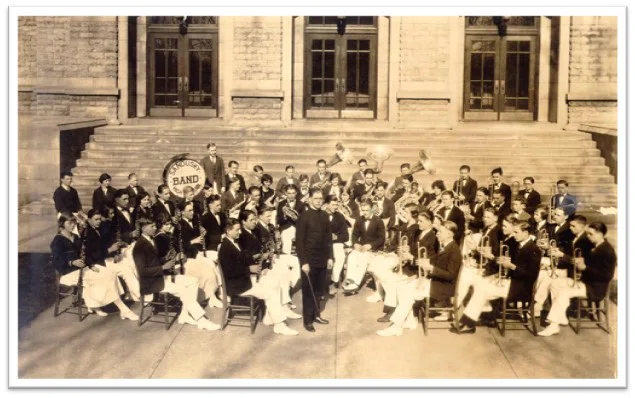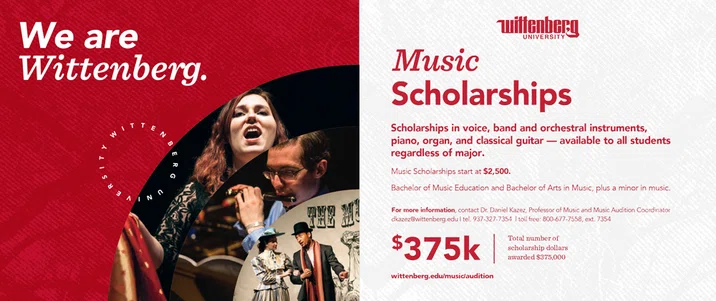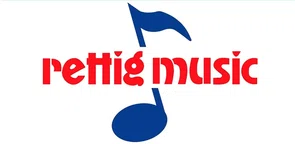


©2023 Ohio Music Education Association
FEATURED ARTICLES
History of Ohio Music Education Association
History of Ohio Music Education Association
Marcus L. Neiman
Historian

As we approach the 100th anniversary of Ohio Music Education Association in 2032, it is appropriate to look back at our historic roots as a music education association to better understand where we have been and where we are now.

Lowell Mason was credited with the introduction of music instruction in the Boston Public Schools in 1828.1 The program was well organized, well-staffed and well-funded. Inservice activities took place to ensure that the programs were a success. Unfortunately, the economic downturn in the 1870s saw music staff cuts and student population increases. Then, as now, when the funding dries up, the first programs to be cut are the arts.
Paul D. Sanders found that early introduction of vocal music into Ohio’s public schools, taught by special music teachers, were found in Zanesville in 1842, Cincinnati in 1844, and Cleveland in 1846.2 Sanders found that many school districts (Cincinnati, 1837; Cleveland, 1838; Oberlin and Zanesville, 1842; Columbus and Dayton, 1848; Massillon, 1849; Dayton, 1849; Toledo, 1856; and Akron in 1859) were offering music instruction by classroom teachers. Rich (1946) reports that, in 1858, vocal music was taught in 64 of Ohio’s 88 counties by 1859.3 Of interest was the classification of music teachers as ‘music supervisors,’ rather than teachers, since they taught in various school.
I remember being told by Del Graff, retired music supervisor for the Medina County Schools Educational Service Center, that during his early years as a county supervisor it was very common for ‘music supervisors’ to travel by bike from one building to another. Any teacher who taught in more than one school was usually referred to as a ‘supervisor.’ During my years as a fine arts supervisor, it was common that music teachers would drive their car from one school to another to teach music classes. And, it was often the case that music teachers would teach in one or more school districts. As school population grew, music teachers were employed with a school district to teach music, then at the individual building level, and finally, within an individual building teaching either instrumental or vocal music.
It should be noted that special in-service for teachers was provided at the first teachers’ institute in Ohio with the purpose of improving public education as held in Sandusky on September 2nd, 1845.4 Each day of the institute was divided into morning, afternoon, and evening sessions, with musical activities conducted several times during each day (described as ‘music,’ ‘vocal music,’ ‘singing,’ ‘exercises in music,’ and, exercises in musical music).5 It was clear that the organizers of the institute and the participants found that music education in-service was valued.
While vocal music in the schools was the norm, most instrumental music instruction in the schools took place outside the school day, either before or after classes. It was likely that local town/community bands made room for young musicians as a recruiting device as well.
In an apparent attempt to promote their product and entertain an audience, the Band Instrument Manufacturers’ Association primarily, and secondarily the music industry as a whole, sponsored the first Schools Band Contest of America in Chicago (IL) on June 4 through 6, 1924.11 The promoters of the event initially hoped for two hundred high school and grammar school bands from all parts of the country to participate; however, only thirty-five “selected” bands would appear in Chicago to compete for the $1,000 first prize. Almost half of the participating bands were from the greater Chicago area (15) with the rest representing nine states.
No history of the Ohio High School Band Association (OHSBA) would be complete without examining the contributions of John W. (Jack) Wainwright.
Wainright received his musical training at the Oberlin Conservatory of Music. In addition to serving as the director of the Oberlin College Band, he maintained a part time job as a linotype operator.6 Wainwright also organized the Oberlin Boys Band in November of 1913.7 He toured extensively with the group under the sponsorship of the Ohio Agricultural Commission making stops in Washington (DC), Philadelphia, New York City, as well as Northern Ohio. Wainwright also served as the director of the Oberlin Adult Community Band and a “Negro Boys Band” in Oberlin.
Wainwright left Oberlin in 1917 to serve in the United States Navy and was assigned to the Naval Reserve Band in Cleveland (OH) where he held the position of solo trombonist and assistant director of the band. A Liberty Bond Drive tour performance in 1918 brought the band to Fostoria, with Wainwright conducting. Wainwright was impressed with the school auditorium, the community, and encouraged a number of local residents to believe he would return to start a boys band in their community.
A year later, in 1919, Wainwright met with the Fostoria Board of Education and negotiated an agreement to start a boys band for the school. The instruments were delivered in February of 1919 and by Decoration Day of that year, the newly formed Fostoria High School Boys Band paraded for the first time.8 By 1923, the Fostoria band made its first concert tour of Eastern Ohio9 by private auto and train.
With bands throughout the Midwestern region of The United States touring and presenting concerts, the time was right for the growth of school instrumental music programs. The band contest movement provided a strong impetus for this growth.10
When the invitation came to perform at the National Contest, Wainwright had positioned the Fostoria band to be musically ready for the venture and, from past touring, had developed a support network within the community that would raise the necessary $2000 in travel money to make the trip.
The contest was to have been adjudicated by panel of distinguished judges. As it turned out, the only adjudicator participating was Lieutenant William H. Santelmann, director of the United States Marine Corps Band, Washington (DC). Santelmann adjudicated the bands on the basis of tone quality, expression, intonation, and precision, with ten points representing perfection in each category.12 Reasons for the low participation sited have been the blatant commercialization of the event and the cost of bringing an ensemble to Chicago.
The Fostoria High School Boys Band, under the direction of Wainright, received the first place-award at the first national school band competition in Chicago (IL) in 1923. The Fostoria band was one of thirty school bands participating in the event.13 The success of a number of bands at this national competition encouraged five states (Illinois, Michigan, New York, Ohio, and Wisconsin) to sanction their own state competitions in 1924.14 Under the direction of Jack Wainwright, the Fostoria High School band, 62 boys strong, in early June 1923 won the National School Band Contest in Chicago. Capt. W.H. Santelmann, director of the U.S. Marine Band, judged the bands in four categories. Fostoria won with 34 points — nine for tone quality, seven for intonation, 10 for precision and eight for expression. The band won $1,000, as well as a $450 set of timpani (kettledrums), a $168 silver flute and a $160 clarinet.
Harrison Technical School of Chicago finished second. Most of the competing schools were located near Chicago, in cities larger than Fostoria. 15
And on June 10, the band and others traveling with it, returned to Fostoria by train to a tremendous celebrational gathering. One hundred years ago, thousands of residents met the train at the Nickel Plate station and watched as the champions paraded to the high school, then located on High Street. 16
Wainwright’s dynamic personality and refined musical talent positioned the Fostoria High School Boys Band to successfully compete; however, what might be more important was that he so encouraged other band directors and communities to start their own bands that we must assume that his leadership strengths drew other band directors interested in developing a state competition to him.
Though they didn’t place, the Sandusky High School band went to a State High School Band Contest in Akron, on May 21 and 22, 1925. The Sandusky Star Journal of May 23, 1925 indicated that “Sandusky gave a splendid account of itself” at Akron.
Twenty-one school bands with a total enrollment of over 1,000 students participated in the first official high school band contest sponsored by OHSBA.
Class A
Akron Central High School Band
Akron South High School Band
Akron West High School Band
Canton McKinley High School Band
Cleveland Central High School Band
Cleveland East High School Band
Cleveland East Technical High School Band
Cleveland South High School Band
Cleveland West Technical High School Band
Fostoria High School Boys Band
Mansfield High School Band
Piqua High School Band
Sandusky High School Band
Carol S. Glover, conductor
Lloyd Haines, conductor
L. Verner Kelley, conductor
Leslie Hanson, conductor
J. Leon Ruddick, conductor
Harry F. Clarke, conductor
Roy Dougan, conductor
Lincoln Elliot, conductor
Peter F. McCormick, conductor
John W. Wainwright, conductor
Todd G. Simon, conductor
P. Paul Gates, conductor
Byron F. Aldrich, conductor
Class B
Addison Junior High School Band (Cleveland)
Bowen-Fraunfelter-Harris Schools Band (Akron)
Firestone-Mason Schools Band (Akron)
Clover-Lincoln Schools Band (Akron)
M. Byron Hughes, conductor
Elmer G. Patterson, conductor
Lloyd Haines, conductor
Lloyd Haines, conductor
Class C
Ashtabula Harbor Special Schools Band
East Technical Junior High School Band (Clev)
Washington High School Band (Massillon)
George W. Wahlstrom, conductor
Roy Dougan, conductor
C.M. Layton, conductor17
The contest opened on Thursday morning, May 21st. On Thursday evening at 8 p.m., the solo contest was held. The solo program included competition for cornet, French horn, flute, saxophone, clarinet, baritone horn, and trombone. The remaining bands performed in the morning session on Friday, May 22. At 3 p.m., a parade of all participating bands was held in the downtown Akron business section. A concert by the massed bands concluded the afternoon session.18
Final ratings were:
Class A
Fostoria High School Boys Band
Akron West High School Band
94.66 (out of possible 100 points)
85 (out of a possible 100 points)
First place
Second place
Class B
Addison Junior High Band
Firestone-Mason School Band (Akron)
First place
Second place
Class C
Ashtabula Harbor Special Schools Band
First place
The 17th Annual Music Supervisors’ National Conference (MSNC) was held on April 7 through 11, 1924 in Cincinnati and we must assume that there were meetings and/or at least conversations going on between Ohio music educators.19 Williams surmised that the MSNC meeting must have a precursor to the founding of Ohio’s first music educator organization. Lee Suman, past OMEA president and state historian, in a letter to Percy Hall stated that the first meeting of the Ohio High School Band Association (OHSBA) took place on June 6, 1924 in Fostoria with 14 charter high school band director members (Byron Aldrich, Sandusky; M. Bryon Hughes Cleveland; Todd G. Simon, Fremont; Harry F. Clark, Cleveland; L. Verner Kelley, Akron; Guy Sutphen, Toledo; Herman Cooper, Marietta; Peter McCormock, Cleveland; John W. Wainwright, Fostoria; J. Claire Hazen, Bucyrus; Milton Niegarth, Cleveland; J. Merton Holcombe, Mansfield; and, C. Henry Rodegerdts, Tiffin).20 This was also the date of the first Ohio High School Band Contest. Williams states that Jay W. Fay, chair of the MSNC instrumental music committee served as temporary chair for the 14 Ohio band directors present in Fostoria for the June 6 meeting for the purpose of forming an organization which would “promote high school band contests.” At this first organizational meeting, John W. Wainwright was elected president; Harry F. Clarke, vice-president; J. Merton Holcombe, treasurer; and Miss. Vivian Pearson was appointed by Wainwright as secretary.
First officers of OHSBA (1924-1925) were elected on June 6th, 1924, Fostoria, Ohio during the first Ohio High School Band Contest.
The OHSBA, the fifth state music education association in the United States, was organized to foster the development of instrumental music in Ohio schools and promote state band contests.21 OSBA held their first state-wide competition in 1925. This ultimately led to MSNC hosting their 1926 national band competition in Fostoria (OH).22
By design, one of the prime goals behind organizing OHSBA was to foster a state sponsored and run high school large group band adjudicated event. Further, a state-sponsored event would encourage Ohio band directors to be part of OHSBA. President John W. Wainwright emphasized his belief that attendance of members at the meetings of the Association, to be held on the last Sunday in October, should be compulsory. He also urged that attendance at the state band contest be compulsory whether or not directors had entered their bands in these events.23
President: John W. (Jack) Wainwright, high school instrumental music, Fostoria (1924-26)
Vice President: Harry F. Clarke, East High School, instrumental music, Cleveland (1924-27)
Treasurer: J. Merton Holcombe, high school band, Mansfield (1924)
Secretary: (appointed by president) – Miss Vivian Pearson, Fostoria (1924-25)
Directors:
Herman Cooper, high school band, Marietta (1924-25)
Guy V. Sutphen, high school bands, Toledo (1924-30)
Appointed: Philip Paul Gat, high school band, Piqua (1924-25)
Appointed: Rush Rosenberry, high school band, Painesville (1924-25)24
The new OHSBA officers and board of directors spent a great deal of time discussing plans for the 1925 state band contest and discussion of judges (adjudicators) to be hired for the contest. The OHSBA membership voted to accept an invitation from the Akron City Schools and Akron Chamber of Commerce to hold the contest in that city. Nellie L. Glover, supervisor of music for the Akron City Schools was assigned to be the contest chair. The event was to be held on Thursday and Friday, May 21-22, 1925 in the Akron Armory.25
Selected judges (adjudicators) for the contest were A.A. Harding (University of Illinois), William F. Robinson (Toronto, Canada), and Albert Sweet (Chicago, Illinois).26 Most of the procedural aspects of the contest were duplicated or modified from the Fostoria High School experiences in the national band contest.
Had Meredith Willson met John W. Wainright, he probably would have written “The Music Man” about Wainright’s exploits in Fostoria leading up to the national band contest. Wainright brought his experience from Oberlin, organizing and conducting boys bands, service bands, and community bands to start the boys band in Fostoria as an extra-curricular activity. He used his promoting and fundraising experience to help move the boys band from an extra-curricular activity into the curriculum. And, his leadership skills attracted other band directors to see the logic of moving away from the expensive national band contest to one centered in Ohio.
The formation of OHSBA centered more on developing a working adjudicated event (contest) for Ohio. The constitution reads more like a manual for running the event than an organization guide. Yet, it is clear now that a functioning adjudicated event was what band directors wanted for their students and it generated interest in an Ohio based organization to make it happen. It should be viewed as a starting point for what was to come in Ohio.
Requiring that those participating band directors be required to not only participate in the adjudicated event, but also attend the event was a wise choice to generate future interest, develop leadership skills, and increase comradery.
The success of OHSBA seemed to generate interest of orchestra and choir directors, many of whom probably not only conducted their school band, but also orchestra and choirs as well. Part II of the series will follow OHSBAs journey focusing on the evolution to the Ohio School Band and Orchestra Association in 1929.
References
1 Howe, Sondra Wieland. JRME 1992, volume 40, no 4, p. 316.
2 Sanders, Paul D. (2001), Vocal Music Education in Ohio’s First Teachers’ Institute, Newark, Journal of Historical Research in Music Education, October 2001 XXIII:1, p. 60
3 Hash, Phillip H. (2004). Philip Cady Hayden and the formation of music educators national conference. Cleveland, OH: Contributions to Music Education (31) 1 2004, p. 115.
4 Burns, James J, The County Institute chapter. In Educational History of Ohio (Columbus, OH: Historical Publishing Co., 1905), p 106.
5 Bianco, p. 15
6 Ibid.
7 Ibid. p. 18
8 Ibid. p. 20
9 Moore, James Edward. The national band contests from 1926-1931. (PhD diss., University of Michigan, 1968).
10 Bianco, Robert S. (1970). The secondary school band competition-festival in the state of Ohio from 1924 to 1969. University of Cincinnati, Ed.D., 1970 Music, unpublished dissertation, p. 8.
11 Holtz, Emil, The national school band tournament of 1923 and its bands, (Unpublished Ph.D. dissertation, University of Michigan, 1960) p. 87.
12 Ibid. p. 1.
13 Ibid.
14 Cottos, Scott. Triumph Like No Other, The Courier https://thecourier.com/news/464477/triumph-like-no-other/
15 Ibid.
16 Bianco. Ibid., p. 41
17 Bianco, Ibild, p. 43
18 Williams, Arthur L. (1969). Report of the historian of the Ohio Music Education Association.
19 Worthington, OH: unpublished state board report.
20 Suman, Lee. (1994). Letter to Percy Hall. Cincinnati, OH: unpublished letter.
Ohio High School Band Association, Constitution, Article I, Section 2, November 1, 1925. (Typewritten).
21 Bianco, p. 2.
22 Bianco, Robert Samuel, Secondary school band competition-festival in the state of Ohio from 1924 to 1969, Cincinnati, OH: University of Cincinnati, 1970. p. 35.
23 Williams, Arthur L. (1969). Report of the historian of the Ohio Music Education Association.
24 Worthington, OH: unpublished state board report (5/23/69), p. 2
25 Bianco, p. 35.
26 Bianco, p. 37.
Marcus L. Neiman is the historian for Ohio Music Education Association (OMEA). He has served OMEA in a variety of capacities and was state president from 1998-2000.
SHARE ARTICLE:



